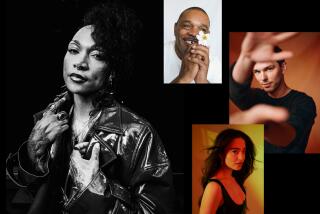When Buff Ruled the Big Screen
- Share via
The videotape is wobbly and faded, but the on-screen action still pulsates with savage Greco-Roman lust. “Watch what happens when she touches my pecs,” says Gordon Mitchell, pointing to the small TV set that rests on a counter in his Santa Monica apartment.
Sure enough, there’s Mitchell in his loin-clothed prime, 40 years ago, a wicked leer on his face, his 50-inch chest swelling with anticipation as a nubile young thing reaches up to stroke his torso. Removing her blindfold, she gasps as Mitchell lewdly wiggles his glistening right pectoral. Then she faints.
Mitchell chuckles at this flickering relic of the days when he and a fistful of other L.A. he-men were kings of a strange, substitute Hollywood based on the Mediterranean shore. It was a place where the men were beefy, the women bosomy, the dialogue dubbed and the cheese factor as pungent as 2-year-old Gorgonzola.
“I was like a god,” says Mitchell, who at 78 is still lean and ruggedly handsome in a Marlboro Man sort of way. “People would get down and actually kiss my feet. I used to get so embarrassed. I couldn’t believe it.”
For its sheer baroque excess and inadvertent self-parody, the B-movie universe that Mitchell once inhabited often strained credulity. Yet from the late 1950s to the mid-1960s, audiences worldwide were in the thrall of movies with such titles as “The Loves of Hercules,” “Medusa Against the Son of Hercules,” “Atlas in the Land of the Cyclops” and “Colossus and the Amazon Queen.”
Made mostly in Italy and Spain, at a fraction of the cost of a typical Hollywood film of the time, these action-hero epics helped turn a small cadre of bodybuilding buffs from L.A.’s Muscle Beach into international superstars. Mitchell alone made roughly 200 films while living in Italy between 1961 and 1989, everything from science fiction to spaghetti westerns.
But the movies for which he and his cohorts are best remembered are of the sword-and-sandals genre. They’re also known as “Hercules” or peplum films, in honor of those curious garments worn by the ancients that resemble a cross between a toga and a miniskirt. All told, more than 170 of these wide-screen, cut-rate Technicolor epics were cranked out between 1958 and 1964.
The vast majority featured American men of minimal acting experience, mostly bodybuilders and Hollywood stuntmen who often couldn’t speak the local tongue, but whose Olympian endowments made them stars in a pastel pastiche of the ancient classical world. They were Cold Warrior pinups on a cartoon New Frontier, rescuing babes and beating back the mongrel hordes.
This afternoon at 2, the city of Los Angeles will honor Mitchell and seven of his muscle-bound brethren as part of a Labor Day tribute to beautiful bodies at the Venice Beach Recreation Center, 1800 Ocean Front Walk. The other seven actors--Mark Forest, Ed Fury, Mickey Hargitay, Brad Harris, Richard Harrison, Reg Lewis and Peter Lupus--all appeared in Hercules movies or myriad knockoffs such as “Goliath Against the Giants,” “Son of Samson” and the immortal Stone Age spectacular, “Wild Women of Wongo.”
Sponsored by the city’s Department of Recreation and Parks, the free event is being organized by the local bodybuilding community and emceed by Bill Howard, a former Mr. America. A bodybuilding competition and a tribute to the late Steve Reeves, whose iconic physical beauty in “Hercules” (1959) ignited the Greco-Roman revival, will round out the afternoon’s enticements.
“These guys have been overlooked, and now we’ve got these gargantuan balloons walking around and nobody remembers what real bodybuilding was,” Howard says.
*
Billed as the first time this unique fraternity has appeared together in the flesh, the event will afford its participants a chance to reminisce, trade stories--and, naturally, compare physiques. “Seeing these guys is going to be kind of interesting, ‘cause I wonder who’s in shape and who’s not, because I am,” says Harris, 68, star of “The Fury of Hercules” and a slew of James Bond knockoffs such as “Kiss, Kiss, Kill, Kill.”
It’s fitting that such a reunion should be occurring at Venice’s Muscle Beach, which inherited the name, if not the Dionysian ambience, of the first Muscle Beach, which was next to the Santa Monica Pier. Between its creation in 1934 and its closing by public order in 1958, the original Muscle Beach was the world’s beefcake capital and center of the then-marginal sport of bodybuilding.
Health-fad entrepreneurs Joe Gold, Vic Tanny and Jack LaLanne were among its habitues, as were several future Herculeses, tough, blue-collar guys trying to break into the middle class. Suddenly, the gyms and the beachfront were the new acting schools in a culture of spontaneous performance and self-display. Among the regular looky-loos were rich society ladies, Hollywood actresses and semi-closeted male celebrities like Rock Hudson and Liberace.
“These married women would come down and throw themselves at the guys,” says film historian Bill Comstock, who’s working on a documentary about the Hercules sub-genre. “They used to call me the Golden Hawk, [because there] wasn’t anything that came down there that I wasn’t on top of,” says Mitchell, flashing his steel-blue eyes. And how did he handle the same-sex overtures? “It didn’t bother me because I wasn’t interested.”
Another admirer of the scene was Mae West, who recruited Mitchell, Hargitay, Lewis and several of their comrades-in-brawn to perform in her double-entendre-strewn live stage revue, which toured the country in the mid-1950s. Like Madonna, the aging but still outrageous West understood that surrounding yourself with scantily clad boy toys is a good way to expand your audience base beyond the usual cabaret crowd.
But while fun, this lifestyle produced few Hollywood job leads for the men of Muscle Beach. In 1949, director Cecil B. DeMille rejected Reeves as too developed to play the lead in “Samson and Delilah,” awarding the part to flabby Victor Mature. Fortunately for Reeves, the 13-year-old daughter of Italian director Pietro Francisci spotted him in the Jane Powell-Debbie Reynolds musical comedy “Athena” (1954) and persuaded her father to cast Reeves as Hercules.
When the movie became one of the top-grossing films of 1959, making Reeves an overnight star, the word went out on Muscle Beach that Rome was the new place to be. “The Italians were smart enough to get the Americans,” says Mitchell. “They had the bodies.”
*
As with most genre movies, the Hercules films were nothing if not formulaic. Besides the barrel-chested heroes, there usually were a pair of pulchritudinous female leads (one good, one evil), slaves, lions, monsters, inexplicable dance numbers, outrageous outfits, bad hair, a slew of stunts, a revenge-driven plot and a splash of throwaway humor.
Like the costumes and sets, the actors and much of the dialogue were recycled from movie to movie. Scripts were typically cut-and-paste affairs that made them easier to dub in multiple languages and redistribute internationally. The vast majority of films were shot silently.
Sometimes, the polyglot casts of American, Italian and other European actors would mouth nursery rhymes or other gibberish. The added dialogue, filtered through multiple translations, communicated in a dubbed pop Esperanto of tone-deaf locutions (“Hey Hercules, throw me a spear!”).
Because they were relatively cheap to make, the movies were enormously profitable. For the lead actors, the Hercules craze proved to be the biggest boon of their careers. Rome’s Cinecitta film studio was a hotbed of creative activity in the early ‘60s, and the city was a magnet for expatriate writers, neo-realist filmmakers and trend-happy jet-setters.
“The Via Veneto, it was magic. You could not walk down the Via Veneto without seeing world-class stars,” says Brad Harris, who toiled in obscurity as a Hollywood stuntman before becoming a household name in Naples. “Everyone was there. Hugh Hefner came over with his playgirls, everybody was going there because it was so much fun and you could buy the best meal in Rome for $15 with everything. It was just a party, and on the weekends we’d all hang out together someplace, we were all making good money, and it was just a wonderful time.”
Palm Springs resident Richard Harrison, who starred in dozens of gladiator, sci-fi and spaghetti western films, has similar memories of his extended Roman holiday. “I had Rolls-Royces, Lamborghinis, I had five houses over there, I had secretaries,” says Harrison, 65, who was selling gym memberships when fame came knocking. How does he account for the films’ success?
“First of all, it was a very clean thing,” Harrison says. “Certainly there was never a dirty word. When you shot in Spain you weren’t even allowed to kiss the girls. You could only hold hands. I wasn’t doing great Oscar-winning performances or anything. But it was a very honest thing.”
As the Hercules series snowballed and the Italian producers began to run out of Greek myths to recycle and Hollywood blockbusters to plunder, they raided lowbrow American pop-culture, mixing and matching genres willy-nilly (“Hercules Against the Moon Men,” “The Three Stooges Meet Hercules”). As Geoffrey O’Brien suggests in “The Phantom Empire,” his 1993 analysis of how movie culture shaped modern consciousness, the Hercules films were a swan song to Western classicism, “the final garage sale of Thrace and Carthage and Byzantium.”
*
But as makeshift and laughably over-the-top as the Hercules movies may appear, connoisseurs regard them as irresistible eye candy, post-modern bonbons minus today’s telltale irony.
“They are camp masterpieces,” says film historian Comstock. “You could never reproduce their ‘failed seriousness,’ as Susan Sontag calls it.”
In fact, in her famous essay “Notes on Camp,” Sontag praised the sub-genre of movies featuring Hercules and the Italian folklore strongman Maciste, “because, in their relative unpretentiousness and vulgarity, they are more extreme and irresponsible in their fantasy--and therefore touching and quite enjoyable.”
Whether campy or not, the movies often were simply flat-out hilarious, though the actors sometimes didn’t notice the humor of what they were doing.
Hungarian bodybuilding champ Hargitay, 75, says that “The Loves of Hercules,” in which he co-starred with his then-wife, Jayne Mansfield, was intended as a serious epic akin to “Ben-Hur” or “Spartacus.”
“I didn’t realize until later how funny it was in certain segments,” he says.
Aside from their comic qualities, Comstock says, the Hercules actors embodied a fascinatingly complex and contradictory masculine ideal. Though represented as warriors, they were among the first men to become mass-market sex objects, both for women and, quietly, among gay men.
Like the T-shirted Marlon Brando of “A Streetcar Named Desire,” the Hercules film heroes represented a transition between the drawlin’, gun-slingin’ machismo of John Wayne and the semi-articulate, secretly sensitive anti-hero figure who emerged in the Italian spaghetti westerns such as “A Fistful of Dollars” and “The Good, the Bad and the Ugly.”
For all their ludicrous feats and hyperbolic builds, the Hercules heroes were loners, outsiders, rugged individualists fighting against a corrupt system. They spoke to a sense of male alienation within the movies and postwar society at large.
In Italy and Germany, where the series was highly popular, Hercules movies offered nostalgic solace (and perhaps a touch of neo-fascist propaganda) to countries still reeling from humiliating defeat.
Art-house filmmakers Federico Fellini and Jean-Luc Godard paid mock homage to this new twist on the classical man of action in movies such as “La Strada” and “Contempt.” (Mitchell even landed a part in “Fellini Satyricon,” the 1970 epic of Roman debauchery.)
Particularly for young gay males in the 1950s and ‘60s, Hercules films were a vital rite of passage, says MGM studios archivist John Kirk. “At the time, you didn’t see a lot of guys with their shirts off,” he says. “It probably was a rare opportunity for kids to get to see guys like that up on the big screen. I’m sure it was a big turn-on to them.”
Through the contemporary lenses of gay and feminist studies, it’s hard not to view the Hercules films as homoerotic, whether intentionally or not.
*
But the by late 1960s, even the most fervid Herculean fantasies had begun to play themselves out. Following the Stonewall riots, the emerging gay subculture began sublimating its energies into art, fashion, disco music.
As postwar prosperity raised Europe’s living standard, the revenge-seeking uber-mensch no longer seemed as relevant. And as Little Richard and Mick Jagger puckered their lips and grew their hair, masculine identity took a new twist.
“I maintain that the Beatles were the ones that really killed these Hercules movies by introducing a more androgynous kind of sexuality,” Comstock says. “If you wanted to get women, this wasn’t going to do the trick.”
Back in his apartment, the video imagery swimming before his eyes, Mitchell fingers a paint drop on his arm. At one time, those arms could bench-press 300 pounds. Today, Mitchell’s body aches, slowed by arthritis. So he’s taken up painting. He’ll have his first solo show Saturday at Tom Binder Fine Arts in Marina del Rey.
His thoughts turn to Steve Reeves, the modern Adonis who made it all possible. “To this day,” he says, “I’ve never seen anybody that could compare to him. He had the looks, the body ... “ Mitchell gropes for a third term, but he’s already said it all.
More to Read
Only good movies
Get the Indie Focus newsletter, Mark Olsen's weekly guide to the world of cinema.
You may occasionally receive promotional content from the Los Angeles Times.










